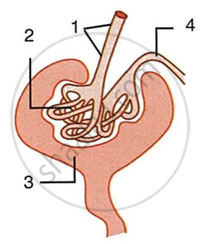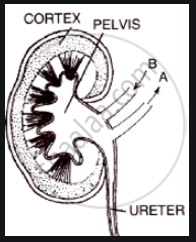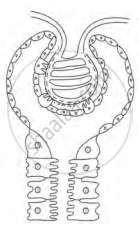Advertisements
Advertisements
प्रश्न
Study the diagram given below and then answer the questions that follow:
 |
- Name the region in the kidney where the above structure is present?
- Name the parts labelled 1, 2, 3 and 4.
- Name the stages involved in the formation of urine.
- What is the technical term given to the process occurring in 2 and 3? Briefly describe the process.
उत्तर
- Renal cortex
-
- Afferent arteriole
- Glomerulus
- Bowman's capsule
- Efferent arteriole
- Ultrafiltration, tubular reabsorption, and tubular secretion.
- The process occurring in 2 and 3 is known as ultrafiltration.
Ultrafiltration: The blood flows through the glomerulus under great pressure, much greater than in the capillaries elsewhere. The reason for this greater pressure is that the efferent (outgoing) arteriole is narrower than the afferent (incoming) arteriole. This high pressure (hydrostatic pressure) causes the liquid part of the blood to filter out from the glomerulus into the renal tubule. This filtration under extraordinary force is called ultrafiltration.
APPEARS IN
संबंधित प्रश्न
Identify the odd one.
Name the two waste products of the human body which are produced in the body cells.
Fill in the blank :
Nitrogenous wastes in the urine are in the form of urea and .....................
Tick the most appropriate answer.
The process of removing waste from the body is called
Choose the correct answer:
Composition of extracellular fluid is regulated by ___________
Given below is a highly simplified diagram of the human kidney cut open longitudinally. Answer the question that follow:
Name the functional units of the kidneys.

Choose the Odd One Out:
Answer the following question.
Amphibian tadpole can afford to be ammonotelic. Justify.
Complete the diagram/chart with correct labels/ information. Write the conceptual details regarding it.

The habitat of animals that excrete nitrogenous waste in the form of urea.
